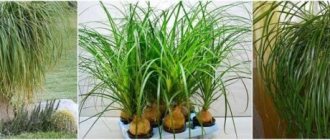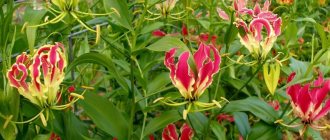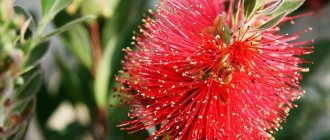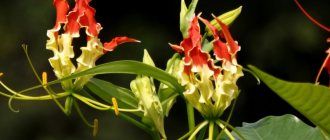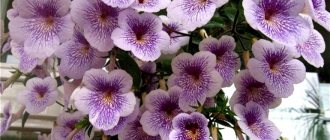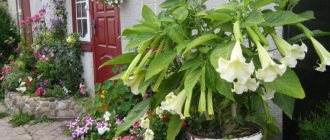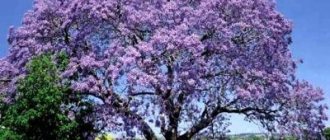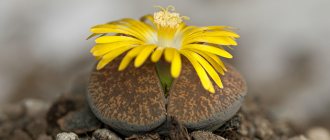Beaucarnea or nolina is a succulent perennial plant from the Asparagus family. In its natural environment it is found in rocky deserts and semi-deserts of North America and in the tropics of South America.
The homeland of bocarnea is Mexico, where, developing most harmoniously, the tree grows up to 10 m. The slender, tall trunk is thickened in the lower part, which is designed to accumulate moisture. Bocarnea develops slowly and unevenly: first, the root zone of the trunk thickens, then its upper part and leaves develop. The leaves grow intensively, descending down in luxurious green curls.
It is not difficult to grow a tree indoors; sometimes it can reach 2 m. Homemade bokarnia does not bloom. In nature, the flowering of nolina is an impressive sight. From a large number of small lilac flowers, it forms large inflorescences similar to panicles.
The plant has several names. One of them, nolina, is associated with the name of biologist and breeder from France P. Nolina. The corky texture of bocarnea bark resembles the skin of an elephant, which is why it is sometimes called “elephant tree.” There are other, less well-known names: “camel tree”, “bottle palm”, “pony tail”.
Be sure to look at a similar plant - dracaena.
| Growth rate is average. |
| Home bokarnia does not bloom. |
| The plant is easy to grow. |
| It is a perennial plant. |
Beneficial properties of bocarnea
Being a natural humidifier and air purifier, bocarnea enriches the air space with air ions and ozone. The plant is used to decorate apartments and offices. It improves the general condition of those in the room and reduces the risk of respiratory diseases. Helps create a favorable atmosphere in the room. In Mexico, sombreros and mats are woven from nolina leaves.
Bokarneya: care at home. Briefly
The big obstacles to growing tropical plants indoors are poor lighting and dry air. Bokarneya grows well at home. You just need to take into account that nolina also has its own preferences:
| Temperature | In the summer season – up to + 20°C, in winter – no higher than + 13°C. |
| Air humidity | Up to 50 %. |
| Lighting | Bright light, south or southeast window. |
| Watering | Rare but plentiful, the soil surface should dry out between waterings. |
| Soil for bocarnaia | Soil for succulents or a mixture of 2 doses of leaf soil, 1 dose of brick chips, 2 doses of clay, 1 dose of sand. |
| Feeding and fertilizer | In summer, once every 15 days, apply fertilizer to succulents. |
| Beaucarnea transplant | .Young bushes - in spring, once every 2.5 years; adults – once every 4.5 years; mature ones do not need to be replanted; only the top layer of the substrate is refreshed. |
| Reproduction | Seeds and apical cuttings. |
| Features of growing bokarneya | For better branching it requires mandatory pinching. |
In order for the plant to look impressive, the gardener must know the peculiarities of growing bocarnea. The tree requires careful care. You need to wipe the leaves carefully: they are very hard and sharp at the edges. When cracks appear on the nolina trunk, they are covered with garden pitch.
To give the plant a unique look, several specimens are planted in one pot at the same time. Planted close to each other, they gradually merge together, forming a powerful trunk. Trimming the tops at different levels allows you to form a stylish crown.
Formation
Nolina does not bloom at home. In order for the plant to have lush foliage, the lighting should be of medium intensity. Watering should be done regularly.
Tuberous
It is necessary to take into account that with such care, bocarnea will lose its strong thickening at the rhizome. It is also recommended to shorten the top to awaken the “dormant” buds. The bush will turn out fit, with lush hair, but a small caudex.
When you want a plant to have a powerful thickening at the bottom of the trunk, it needs to be provided with bright light in winter with a minimum amount of watering.
The caudex will grow, the bush will not grow tall.
Caring for bokarneya at home. Details
Home bokarnia is an unpretentious plant, but in order for its unique beauty to be fully revealed, you need to create optimal conditions.
Flowering nolina, bocarnea
Under natural conditions, only mature bocarnea blooms, forming many tiny light lilac flowers collected in panicles.
Beautiful long inflorescences descend from the top of the tree, spreading a delicate aroma around. Flowering of nolina and bocarnea at home is impossible. The plant only occasionally forms a peduncle, which is pinched to form a beautiful crown.
Temperature
To make the tree look attractive, it is necessary to maintain a certain temperature regime. In winter, the nolina plant should be kept at + 7 – 13°C. In summer, it is advisable that the thermometer does not rise above + 20°C.
Drafts are contraindicated for the tree (especially in combination with high humidity).
Spraying
Bocarnea prefers average air humidity, so spraying is carried out only in hot weather with dry soil. They do this carefully, trying not to touch the trunk. Sometimes the foliage is wiped with a clean soft cloth.
Lighting
The tropical bocarney plant feels great at home in the southeastern and southern zones of the house. It is here that it will receive the bright lighting necessary for development. In less bright places, nolina will slow down, or even stop, its growth.
It is recommended to turn the tree with different sides to the sun to form a beautiful crown. When warm weather sets in in the spring, the plant is taken out into the fresh air. Place away from prevailing winds and drafts. The duration of daylight for normal development of bocarnea should be at least 10 hours. In winter, phytolamps are turned on.
Watering bocarneya
Excess moisture can destroy nolina.
Enough time should pass between waterings so that the surface of the substrate has time to dry. Bokarneya is watered infrequently, but quite abundantly: in the summer - every 5 days, in the autumn and spring - after 12 days. In winter, watering is stopped. The colder it is outside, the less often you should water. A clear sign of the need for watering is the shrinking and softening of the trunk. Use settled lukewarm water.
Nolina pot
The root system of the plant is located superficially, so nolina grows favorably at home and feels good in a low, wide container. Each new pot for nolina should be 2.5 cm larger than the previous one and stand steadily on a flat surface.
When determining the height of the pot, you need to understand that 1/3 of it is filled with drainage. There should be holes made at the bottom of the container for drainage. Mature plants are planted in tubs.
Soil for bocarnaia
Caring for bocarney at home requires planting the plant in a loose, breathable substrate. You can prepare your own soil for bocarnea from two parts of leaf soil and clay and one part of sand and brick chips. You can buy a soil mixture for succulents in the store and supplement it with charcoal powder and chopped sphagnum.
Feeding and fertilizer
When watering the bocarnea, combine feeding and fertilizing with a solution for succulents, diluted by half. The plant is fed only in summer, once every 14 days. After feeding, the plant is kept in the shade for 2 days.
Transfer
Young bushes are replanted once every 2.5 - 3 years, adults - once every 4.5 years, when they need a pot of a larger diameter.
Mature plants that are more than 15 years old should be replanted only in extreme cases: when the root or trunk rots. In other cases, they only refresh the top layer of soil. Bocarnea is transplanted in the spring. This is done very carefully so as not to damage the roots and not to deepen the growing point. After transplantation, nolina can be watered after 4 days, and fed after 2.5 weeks.
How to prune bocarneya?
Plants are pruned to remove damaged parts or to give the crown a neat appearance. Nolina pruning is carried out irregularly, according to the decision of the grower. Each new “haircut” allows the tree to look neat and stylish.
Rest period
Bocarnea can grow tirelessly throughout the year, but rest is necessary for every living creature to prolong its existence and improve its health. A caring owner will artificially create a dormant period for the plant in winter, lowering the temperature to + 13°C, limiting watering and refusing stimulating fertilizing.
In this case, the bokarnia will get stronger over the winter and, healthy, will meet a new spring.
Transplantation: pot, soil, step-by-step description
The pot needs to be shallow but wide, because the root system is superficial. The transplant container should have large holes for drainage.
For young plants, plastic pots are used. For mature specimens - made of ceramics.
Beaucarnea is not picky about the soil. However, the best option would be loose soil that allows moisture to pass through with medium acidity. You can make it yourself or buy it ready-made.
How to properly plant a bush in a new container (step by step):
- a drainage layer is laid out;
- 1/3 of the substrate is poured (the container and soil are pre-disinfected);
- planting is carried out by transshipment (the earthen ball must not be damaged);
- the roots are sprinkled with earth, which is compacted;
- the bush should sit tightly in the soil (sprinkle with expanded clay or gravel);
- The transplanted nolina is placed in partial shade and is not watered for three to five days.
Young specimens need to be replanted annually. Adult plants - once every 3-4 years. The pot should be 3-4 cm wider than the previous one.
It is not difficult to understand that transshipment is necessary: the root system will begin to emerge from the drainage holes.
Reproduction of nolina, bocarnea
Getting a new tree at home is not easy. Propagation of nolina and bocarnea is possible in two ways.
Growing bocarnea from seeds
Such propagation is complicated by the fact that at first they germinate poorly and then germinate slowly. It takes almost a month to germinate seeds in mini-greenhouses at + 25°C. Further, the plant develops very slowly.
Reproduction of bocarnea by shoots
This is possible only when the side shoots are formed (this does not always happen). The shoot is cut with a sharp knife and treated with a root formation stimulator. Having placed it in the ground, cover it with polyethylene (remove it to ventilate and water the nolina). When the first leaves appear and the plant takes root, the film is removed.
Sometimes the apical shoot of bocarnea is rooted. This breeding option is considered easier and faster.
Diseases and pests
Bokarnia is affected by diseases and pests due to illiterate or careless care. The plant changes appearance:
- bocarney leaves become smaller - the container has become small, there is a deficiency of nutrients (replace the container, feed);
- bocarnea leaves turn pale and bend easily - high temperature, little light (move to a cooler and brighter place);
- the tips of the nolina leaves dry out - dry air (spray, place in a tray with wet expanded clay);
- the bocarnea stem shrinks – moisture deficiency (adjust watering);
- Nolina leaves droop and dry - the plant is hot, there is insufficient lighting (reduce the temperature, put it in a brighter place);
- Nolina leaves turn brown and fall off - excess moisture (do not water for several days, then adjust watering);
- the trunk does not grow in thickness - frequent watering, little light (adjust watering, move to a brighter place).
At home, bokarneya may suffer from attacks from scale insects, mealybugs, and spider mites. Insecticides are used against pests.
Types of bocarnea, homemade nolina with photos and names
There are approximately 30 species of bocarnaea in the wild. Only a few of them can be grown at home.
Nolina recurvata
The most common type of homemade bocarnea. The height of an adult tree can reach 2 m, the diameter of the thickened part of the trunk is about 1 m. The top of the trunk is “decorated” with sinuous elongated (up to 100 cm) leaves. The dark green leaf blade is narrow (up to 20 mm) and dense. The plant is called “elephant’s foot” based on the shape of its trunk, and “horse’s tail” based on its lush crown.
Nolina Lindheimeriana
A low tree. The trunk is almost invisible. The top is crowned with a lush tuft of elongated narrow leaves, colored light green. The popular name is "devil's lace".
Nolina longifolia
Large powerful tree. The height reaches 4 m. The texture of the trunk resembles a cork covered with cracks. The leaf blades are wide (up to 4.5 cm) and elongated. They have a light green tint.
Bokarneya is a welcome exotic in the house. A stylish plant emphasizes the individuality of the interior, bringing sophistication and elegance to it.
Types for indoor breeding
There are more than thirty types of bocarnea. However, not all of them are suitable for indoor breeding. The following varieties are usually grown in an apartment:
| Variety | Peculiarities |
| Longifolia | The plant is large: it is often grown in special greenhouses. It has an erect trunk, widened at the root. The bark is corky. Older copies crack. The arched leaves are hard and belt-shaped. They grow in bunches at the top. Over time, they dry out and descend, forming a “skirt” covering the trunk. |
| Bent (recurvata) | The most popular variety for growing at home. Reaches one and a half meters. The trunk is erect with a widening at the bottom. The green, ribbon-shaped leaves form rosettes and hang from the top. Over time they become “curly”. It is about one meter long and one to two centimeters wide. |
| Matapskaya | Belongs to a low-growing variety. In nature it does not grow more than two meters. The leaves do not fall off after withering. They form a “skirt” around the trunk. |
| Lindenmayer | A low-growing variety with a weakly defined trunk. The leaves are dense and elongated. The plant is popularly nicknamed "devil's lace." |
| Nelson | In young specimens it is almost impossible to see the trunk: it is covered with greenery. The bluish-green leaves are hard with jagged edges and stick out to the sides. With age, they disappear and the plant becomes bare. Reaches three meters. |
| Tuberous | Grows up to two meters. It gains three to five centimeters in height per year. Caudex is present in adult bushes that have reached the age of twenty. |

